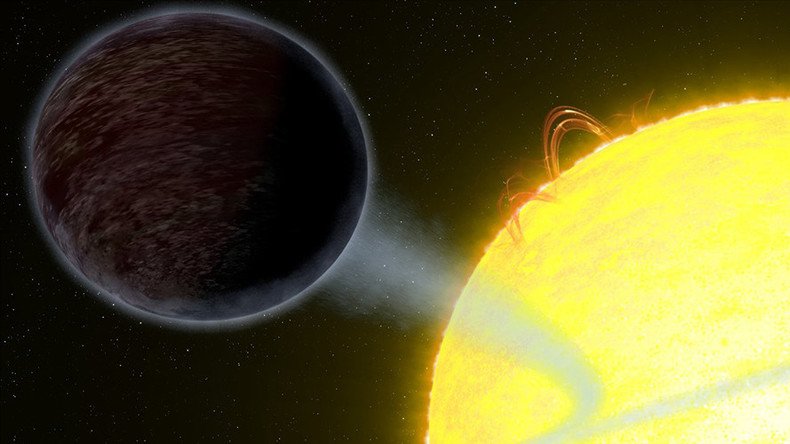Hubble spots pitch-black exoplanet so hot it ‘eats light’ from nearby star

Scientists studying the exoplanet WASP-12b have made a startling discovery: the planet is so hot it reflects almost no light, making it appear pitch-black.
An international team of astronomers from McGill University, Canada and the University of Exeter, UK measured how much light is reflected by the exoplanet, otherwise known as its 'albedo,' in order to better understand the chemical makeup of the planet's atmosphere.
Only the Space Telescope Imaging Spectrograph (STIS) on the NASA/ESA Hubble Space Telescope is powerful enough to carry out such immense measurements.
“The measured albedo of WASP-12b is 0.064 at most. This is an extremely low value, making the planet darker than fresh asphalt,”said Taylor Bell, a Master’s student in astronomy at McGill University.
For context, WASP-12b has an albedo of 0.064, making it half as reflective as our moon (0.12).
“The low albedo shows we still have a lot to learn about WASP-12b and other similar exoplanets,” Bell added.
Astronomers find evidence of water on TRAPPIST-1 exoplanets https://t.co/oQnt4ZGy1v
— RT (@RT_com) September 2, 2017
WASP-12b orbits a star similar to our sun, roughly 1,400 light-years away from Earth. The exoplanet is classified as a 'hot Jupiter' or 'roaster planet,' a type of gas giant that has a very short orbital period of less than 10 days.
This means that the exoplanet is in very close proximity to its star, which not only stretches it out into an egg shape but also raises the surface temperature on WASP-12b’s sunny side to 2,600 degrees Celsius (4,712 Fahrenheit).
“There are other hot Jupiters that have been found to be remarkably black, but they are much cooler than WASP-12b," Bell explains. “For those planets, it is suggested that things like clouds and alkali metals are the reason for the absorption of light, but those don’t work for WASP-12b because it is so incredibly hot.”
'First time glowing water molecules were observed on an exoplanet' -
— RT (@RT_com) August 4, 2017
#NASAhttps://t.co/YbreCEye8wpic.twitter.com/4aUj9rT2Zn
The exoplanet is so hot that clouds cannot even form. The atmosphere is rich in hydrogen atoms, which makes the exoplanet have an atmosphere closer to that of a low-mass star. Hydrogen atoms are quite rare in planetary atmospheres due to the element’s highly reactive nature.
Scientists measured the exoplanet's albedo during an eclipse in October 2016 when it passed behind its star.
“After we measured the albedo we compared it to spectral models of previously suggested atmospheric models of WASP-12b,” Nikolay Nikolov (University of Exeter, UK), co-author of the study, said.
“We found that the data match neither of the two currently proposed models.”
Sun’s twin ‘Nemesis’ could have caused dinosaur extinction before venturing off into galaxy, new analysis shows https://t.co/mze4LiP5htpic.twitter.com/qk522DQ1lc
— RT (@RT_com) June 15, 2017
WASP-12b does not reflect light at any wavelength, giving it a red hue similar to molten metal, in sharp contrast to the other 'hot Jupiter' that has been studied by astronomers and astrophysicists in such detail, HD 189733b, which has a deep blue color.
“The fact that the first two exoplanets with measured spectral albedo exhibit significant differences demonstrates the importance of these types of spectral observations and highlights the great diversity among hot Jupiters,” Bell concludes.












